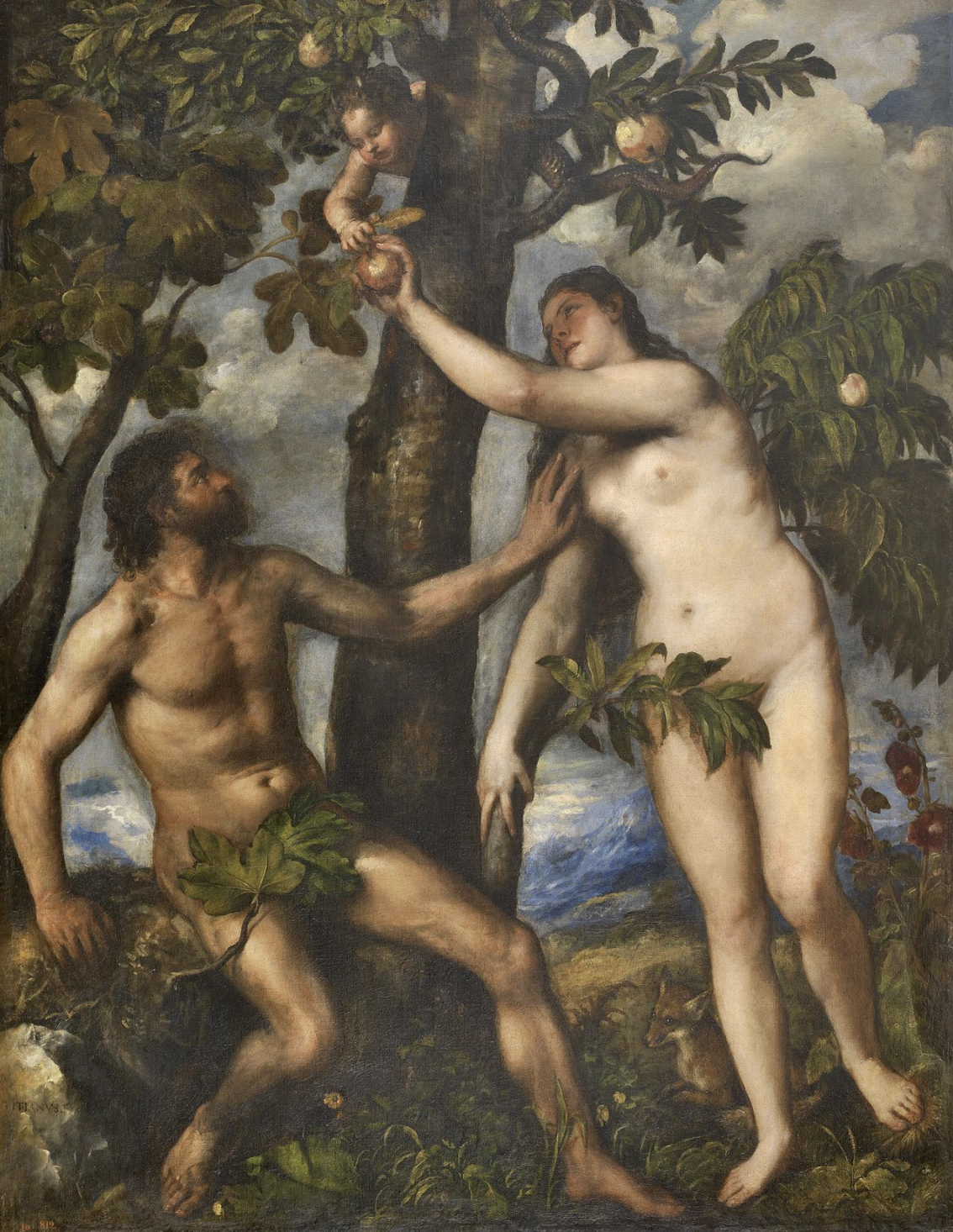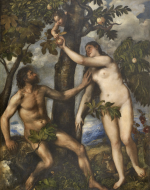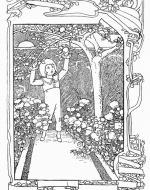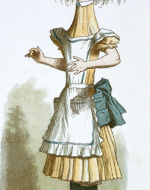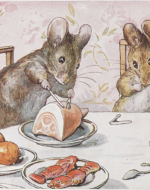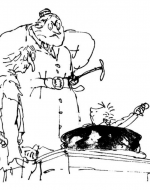Created by Lola Bessis on Mon, 03/01/2021 - 14:07
Description:
Food is a present theme in children’s literature throughout the centuries, often symbolized as being either a treat or a warning to its consumers. Food appears in the Bible, such as the story of Adam and Eve in Genesis, didactic texts of the nineteenth century, and twentieth-century entertaining children’s novels. The theme of food as a treat or a warning appears in many authors’ and artists' works depicted in this case; Titian, Mary Martha Sherwood, Lewis Carroll, Beatrix Potter, and Roald Dahl each address the topic in significantly different ways but with surprising similarities. According to Ritta Oittinen in "The Verbal and The Visual: On the Carnivalisim and Dialogics of Translating for Children" in The Translation for Children's Literature, the fields of Biology and Psychology provide insight into young children’s love for sweets, as it is their most developed taste receptor. This belief has led to numerous stories in children’s literature revolving around cakes, fruits, jams, and tarts. This chronologically arranged analysis of texts and paintings depicts the similarities found in the message of food throughout centuries of children's literature. The harsh consequences of overindulgence as seen in didactic texts carry from Titian's depiction of the Biblical story of Adam and Eve to Mary Martha Sherwood’s adaptation of it on to Lewis Carroll, Beatrix Potter, and Roald Dahl, who take more humorous approaches to the subject.
Titian, The Fall of Man (ca. 1550).
The Christian Biblical text, The Book of Genesis, gives a religious account for the creation of the world. It tells the story of Adam and Eve, who commit the original sin, eating an apple off a forbidden tree. Adam was created by God, who later put Adam to sleep in order to cut him open and create Eve from one of his ribs. These connected beings were given a wide variety of plants and trees from which they could eat. God also gave them the Tree of the Knowledge of Good and Evil, which was forbidden to eat from. God tells Adam and Eve that if they were to eat from the tree, they would die. After eating from the forbidden tree, the pair try to hide from God. This proves to be useless as He is all-knowing. God pretends to look for them in hope that they confess their sin. After they fail to acknowledge their wrongdoing, God decides to punish them harshly. Adam must work hard, and Eve will have to bear children with great pain. They would now have to provide for themselves with their own hands, and they no longer had a personal communion with God. Humans now must live with these consequences, and children are read this story as a warning in order to educate them on the need for salvation to enter heaven in the afterlife. Titian’s illustration of Adam and Eve shows the two standing under the apple tree. Eve is reaching to grab the apple a devil is handing to her. Adam seems to be trying to stop her by resting his hand on her shoulder. Children in the twenty-first century growing up in religious Christian households are still told the story of Adam and Eve.
Florence M. Rudland, "There Was One He Could Just Reach," for "Story of the Apples," in The Fairchild Family (1847), by Mary Martha Sherwood.
Mary Martha Sherwood’s The Fairchild Family (1818, rev. 1847) was a popular Sunday School prize book well into the 20th century. Her didactic text “Story of the Apples” follows Henry Fairchild, a young boy who sneaks into his family’s garden early one morning to steal an apple from a newly blossoming tree his father specifically asked the children not to touch--this scene is illustrated by Rudland. Sherwood here is making reference to the original sin, as depicted in Adam and Eve’s story from “Genesis.” For his sin of stealing the apple and lying to his parents, Henry is punished by being locked in a small room in their house where he is neither fed nor talked to. Henry proceeds to pray to God, begging to be forgiven. His mother eventually comes to collect him. She gives him a long and harsh lecture about sinning. Once Henry has assured her that he has learned his lesson, he is finally given dinner. This dramatic and somewhat tragic story of a child letting his curiosity and hunger get the better of him warns child readers to not repeat a similar mistake. The theme of food as temptation is a warning tale to other children; similarities appear in Sherwood's and Adam and Eve’s tales. Rudland's and Titian’s illustrations also strongly resemble one another in the choice of the painted moment. Henry Fairchild is illustrated similarly to Eve, reaching to grab the fruit from the tree. In Sherwood’s text, Henry Fairchild’s eating of the forbidden apple is portrayed as a grave sin, but his punishment is only short term.
John Tenniel, “Alice with Long Neck,” for Alice’s Adventures in Wonderland (1865), by Lewis Carroll.
Lewis Carroll’s Alice’s Adventures in Wonderland follows a little girl filled with curiosity. She displays all the expected characteristics of a Victorian-era young woman; she is polite, well-mannered, and courageous. Unlike the popular didactic texts of the time, the protagonist, Alice, is not punished for her curiosity. The novel begins with her chasing an odd-looking rabbit down a rabbit hole. This hole is revealed to be a sort of portal to Wonderland, a magical place where Alice will be encountering many challenges. In an early scene, Alice is seen eating cakes and mushrooms and drinking potions without specific instruction to do so. In comparison to earlier didactic texts, Alice is not punished. She often just grows taller or shorter. Tenniel illustrates this by giving Alice a dramatically long neck. Although the distortion is temporary, the young girl’s expression displays a degree of discomfort. Her actions further the story and help Alice access new parts of this Wonderland. Carroll is embracing the journey of growing up and portrays food to be more of a treat than a warning. He allows Alice to make mistakes and try different foods without being faced with tragic consequences. Carroll is introducing to the Victorian children a new genre of literature, one where the author’s goal is not to scare children into submission but instead to entertain them. This theme, as well as Alice being able to try various foods, acknowledges that a child is an innocent being who is simply trying to navigate and understand the adult world, and that food is a treat that can be consumed by children to the extent they may desire.
Beatrix Potter, “It is Not Boiled Enough," for The Tale of Two Bad Mice (1904).
Through the use of humor, Beatrix Potter finds a medium ground in the portrayal of food in children’s literature. She presents the idea that fictional food is not always delicious and is sometimes disappointing in her book The Tale of Two Bad Mice (1904). The story follows mice Tom Thumb and Hunca Munca as they go on a destructive rampage after their failed attempt at eating food from a dollhouse, which they humorously find out is made entirely of painted plaster in this scene illustrated by the author herself. They destroy all the plastic food and most of the furniture in the dollhouse. Hunca Munca proceeds to steal various small items from the dollhouse. A mousetrap is set, threatening the lives of the two bad mice. To avoid death, Tom Thumb pays for what they have broken, and Hunca Munca comes to clean the dollhouse every morning. The toy food can be interpreted as a metaphor for desire and greed. The food is described as an expensive meal with lobster, ham, fish, pudding, and much more. This is a story written and illustrated by Potter for children. It can be inferred that this cautionary tale warns the target audience about the consequences of acting too readily upon greedy desires.
Quentin Blake, “Bruce and the Cake,” for Matilda (1998), by Roald Dahl.
Roald Dahl’s Matilda is a much more recent novel than the other selections. Published in 1988, the book is still read and adored by 21st-century children. Although written for and about modern children, the warning theme of food dating from the Bible is still very much present. Bruce Bogtrotter, a pupil at Matilda's elementary school, is called up on stage during a special assembly by the headmistress, who accuses him of stealing a piece of cake from her secret stash and manipulates him into confessing. Bruce’s punishment doesn’t end at the embarrassment he feels at being humiliated in front of his classmates, but the headmistress proceeds to put an entire foot and a half long cake on the table before him. She forces him to eat the entire cake, which he painfully does to avoid any more severe punishment. Blake’s illustration of the scene shows Bruce in front of the cake with his mouth full, looking back at the headmistress and the cook who both hold angry expressions. Although this can be seen as funny, light-hearted, or a big joke, the subliminal messages about the dangers of food are as present in this 1988 text as in earlier nineteenth-century didactic texts and are even comparable to Biblical texts with greedy actions being punished with harsh consequences.

